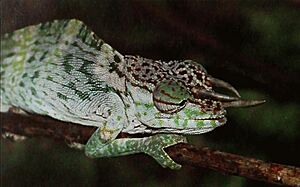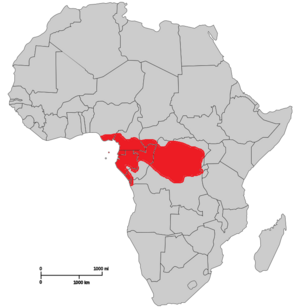Owen's chameleon facts for kids
Quick facts for kids Owen's chameleon |
|
|---|---|
 |
|
| male | |
| Conservation status | |
| Scientific classification | |
| Genus: |
Trioceros
|
| Species: |
oweni
|
 |
|
| A map illustrating the range of Owen's chameleon | |
| Synonyms | |
|
|
Owen's chameleon, also called Owen's three-horned chameleon, is a special kind of lizard. It belongs to the chameleon family. These amazing creatures live in the forests of central Africa. A British explorer named William Fitzwilliam Owen inspired its name. The naturalist John Edward Gray first described this species in 1831.
Contents
Where Owen's Chameleons Live
Owen's chameleons can be found in many parts of tropical central Africa. Their home stretches from Nigeria in the north to Angola in the south. You can also find them as far east as Burundi.
Their Forest Homes
These chameleons prefer to live in thick evergreen and semi-deciduous forests. They usually stay in large trees. They live in areas that are lower than 800 meters (about 2,600 feet) above sea level. The first place this species was found was on the island of Bioko in Equatorial Guinea.
What Owen's Chameleons Look Like and Do
Like many other chameleons, Owen's chameleon has a tail that can grip things. It also has a single claw on each of its toes.
Cool Features of Males and Females
Male Owen's chameleons have three smooth horns on their heads. Females do not have horns. Instead, they have loose skin on their back legs. This skin makes it look like they are wearing baggy trousers!
Size and Weight
Adult Owen's chameleons are usually about 25 to 28 centimeters (10 to 11 inches) long. This measurement includes their tail. A typical Owen's chameleon weighs around 75 grams (about 2.6 ounces).
How They Behave
These chameleons mostly live in trees. They are very good at moving from branch to branch. If a predator comes near, they might leap to another branch or even to the ground to escape. Their main diet is insects.
Protecting Owen's Chameleons
The International Union for Conservation of Nature says Owen's chameleon is a species of "Least Concern." This means their numbers are stable and they are not currently in danger. This is because they live in a wide area and there are many of them.
Challenges They Face
However, there are still some worries for these chameleons. Logging (cutting down trees) and expanding farms can lead to deforestation. This means their forest homes could shrink.
Other Uses and Beliefs
Sometimes, Owen's chameleons are caught for the pet trade. They are also sometimes used in local traditions. For example, some tribes in the Democratic Republic of the Congo believe that a scorched chameleon can be a protective charm. Near Yaounde in Cameroon, people use them as a treatment for certain illnesses.


